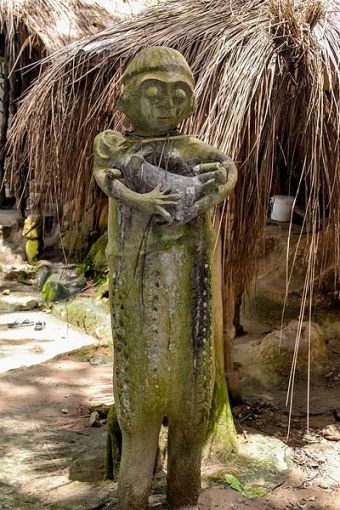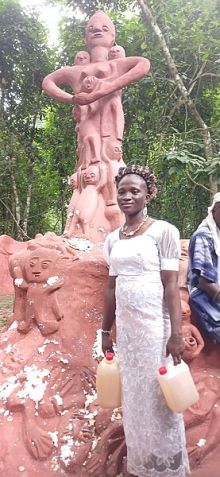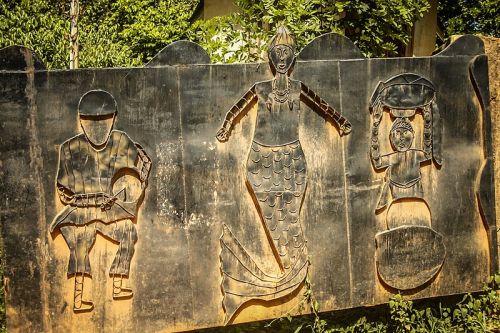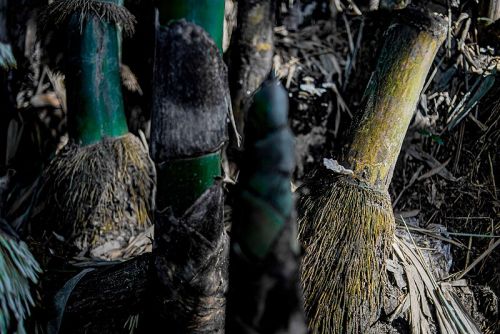Osun, also spelled Oshun, is an orisha (deity) of the Yoruba people of southwestern Nigeria. She is the goddess of divinity, femininity, beauty, and love. Oshun is commonly called the river orisha, or goddess, in the Yoruba tribe and is typically associated with water, purity, fertility, love, and sensuality. She is the youngest orisha and is considered one of the most powerful of all orishas, and just like the others, she equally possesses human attributes such as vanity, jealousy, and spite.
Osun is often depicted as charming and beautiful. She is often painted admiring her beauty in a mirror because of her charmingness. She is trying to show her devotees, there is power in self-love and self-confidence.
This article covers Osun, the river goddess from an authentic Yoruba perspective, exploring her origins, myths, ways of worship e.t.c
Mythology of the Yoruba deity, Osun
Several myths exist concerning Oshun and her origin.
The Yoruba people believe that once upon a time, Olodumare, the supreme God sent 17 orishas in human identity to multiply and frutify the earth. Osun was one of these 17 orishas and was the only female orisha.

However, after reaching the earth, Osun was singled out and was presumed useless for the task, thinking it was a man’s job to revive humanity so they all tried to do it all on their own, but all failed in their attempts of populating the earth.
After so many unsuccessful attempts, they decided to go back to the supreme god in heaven to explain what had happened hoping that he would have a solution. Upon hearing their plea, the Olodumare told them the solution to their plea left heaven with them and has not returned ever since.
The Orishas realized it was Osun, the supreme god was talking about and they also realized no masculinity can produce life on its own, so they needed Oshun for fertility to make life blossom on earth.
The male orishas searched for her and asked for her help which she accepted, brought off sweet and powerful waters, and created humanity bringing life back to earth and existence to other species. This is why Osun, to date, is considered the nurturer of humanity.
Significance of Osun
- Fertility: Osun is primarily known as the goddess of fertility. People with fertility difficulties do invoke her for assistance in matters of conception and childbirth. Osun is believed to have the power to bless women with the ability to conceive.
- Healing: Osun is believed to possess healing powers. Her association with freshwaters and purity connects her to the idea of cleansing. Devotees often visit Osun’s sacred groves and waterfalls where they seek assistance in physical and spiritual healing.
- Divine motherhood: Osun is often seen as a divine mother figure and is seen as a powerful and nurturing protector of women and children.
- Unity and harmony: osun is believed to promote unity and harmony, and is often invoked in rituals and ceremonies to promote peace.
- Guidance: osun is said to provide sacred knowledge wisdom and resilience and is often revoked in rituals to promote self-empowerment
- Resilience: Osun is believed to embody inner strength and resilience and is often revoked in rituals to promote self-empowerment.
Attributes of Osun

Osun possesses various attributes that reflect her multifaceted nature and powers. Here are some of the key attributes of the orisha:
- Beauty: Osun is often depicted as a beautiful and alluring figure, with fine features and a radiant smile. Her beauty is said to be so captivating that it can mesmerize anyone who lays eyes on her.
- Fertility: Osun is associated with fertility and the power to bring forth life. She is often invoked by women who are trying to conceive and is believed to have the power to bless them with children.
- Love: Osun is the embodiment of love and passion, and is often sought out for guidance and healing in matters of the heart.
- Motherhood: Osun is revered as a divine mother figure, nurturing and protecting her children and community. She is often depicted with a child or children by her side, emphasizing her maternal role.
- Healing: Osun is believed to have healing powers, and is often sought out for guidance and healing in times of illness or suffering.
- Creativity: Osun is often depicted as a creative and artistic figure, and is believed to have the power to inspire and guide those who are seeking to express themselves through art, music, or other forms of creative expression.
Human attributes of Osun.
In Yoruba mythology, deities are depicted with human-like emotions and characteristics to help people relate and understand them better.
- Jealousy: The idea of Osun’s jealousy is rooted in her passionate nature and her deep love for her devotees. She is known to be protective of those who worship her and she expects their loyalty in return. When she feels neglected, she may exhibit behaviors that are interpreted as jealousy.
- Vanity: The portrayal of Osun’s vanity is rooted in her association with beauty, sensuality, and charm. As the goddess of love, beauty, and freshwaters, she is believed to embody these qualities in their fullest expression. This association with beauty and allure can sometimes be interpreted as vanity.
- Spite: While Osun is not commonly depicted as spiteful, there are instances in mythology where she may exhibit a sense of displeasure or take action when she feels wronged or disrespected. This is often in response to the neglect or mistreatment of her devotees or when her honor and authority are challenged.
Symbols associated with osun

Symbols associated with Osun include entities like mirrors, hand fans, golden beads animals like peacocvultures vultures, and bright colors like gold, yellow, and coral.
Objects
Mirrors: osun was always going around with a mirror which shows self-love and self-confidence.
Hand fan: Osun was always with an Aahandd fan which signifies her royal status.
Golden beads: Golden bead signifies gold, glamor, and beauty.
Colors
Yellow and Gold: Oshun is traditionally associated with the colors yellow and gold. She is often wearing yellow clothing and adorned with gold jewelry. Offerings to Oshun may include yellow and gold items.
Animals
Peacock and vulture: Peacocks and vultures are associated with Osun because of their god-like appearance and features.
Worship and festivals
ORIKI OSUN (PRAISE POETRY OF OSUN]
Ore yeye osun.
Osun sense
Oloriya iyun,
Arewaopinion,
Osun oyeeyee nimo
Awede we.
Mother Osun,
Praise to the mother of mystery
The one who has a comb made of coral beads
The beautiful lady.
Osun the very knowledgeable one
Spirits that lean me inside out.
Yeye mi olowo aro
Yeye mi else osun
Yeye mi ajimo roro.
Yeye mi animal ma yank
Yeye mi alagbo awoye.
Eleti groin
Ogbagba ti gbomo re lojo ija.
Ari bani gbo nipa tomo.
My mother with hands colored by dye
My mother’s feet whose feet are of Camwood
My mother is always found neat.
My mother whose child never dies.
My mother is the owner of super healing decoction.
Ever ready to hear
The one capable of delivering her children.
She cares for one concerning children.
Osun and osogbo
The first encounter between Osun and humanity took place in Osogbo city(note: osogbo is the capital of Osun state, a state named after the deity in Nigeria). It is believed that it was fiercely protected by the orisha. It is believed that the Sun granted the people of the city permission to build Osogbo near the Osun River and promised to provide for them and grant their prayers and wishes.
Osun festival
Every year, devotees would go to the Osun River to pay tribute to the orisha and pray for a variety of things like wealth and children. The procession is led by a young female, especially a virgin from the king’s lineage called arugba(carrier of calabash).
Offerings for Osun include food items like Akara(bean cake), sugar cane, Ekuru(Bean pudding), chewing gum, sweets, pineapple, and honey.
Osun Osogbo Sacred Grove

Osogbo is the home of a sacred forest called the Osun Osogbo Sacred Grove. The sacred site dates as far as five centuries ago.
It is said to be the last of the sacred groves in the Yorubaland. It was the lonely site that survived Christianity which makes it so precious to the Yoruba people.
across borders

As orisha Oshun, she has had a significant influence beyond the Yoruba culture, particularly in Afro-Caribbean religions like Santeria and Candomblé in Cuba and Brazil. In these religions, Oshun is worshipped as a powerful and nurturing goddess who is associated with fertility, love, and protection.
Santeria
In Santeria, Oshun is considered the patron saint of women and children and is often invoked for protection and guidance. She is also associated with the color green, which is a symbol of fertility and prosperity in Santeria. Oshun is worshiped alongside other Afro-Cuban deities, such as Yemaya and Ogún, in the religion known as Santería.
Candomble
In Candomblé, Oshun is worshipped as a powerful and nurturing goddess who is associated with the earth and the cycles of life. She is often invoked for protection, guidance, and healing. Oshun is worshiped alongside other Afro-Brazilian deities, such as Oxum and Xangô, in the religion known as Candomblé
Taboos of Orisha Osun
These taboos are designed to maintain her purity and power, as well as to protect her worshipers from harm. Here are some of the taboos of Osun:
- Adultery: Adultery is a form of impurity that can pollute the sacred space of Osun. As such, anyone who has committed adultery is prohibited from entering Osun’s shrine or participating in her rituals for some time.
- Prostitution: Prostitution is a form of impurity that can pollute the sacred space of Osun. As such, anyone who is a prostitute or has engaged in prostitution is prohibited from entering Osun’s shrine or participating in her rituals.
- Certain foods: Certain foods are considered to be impure and are prohibited from being consumed by Osun’s worshipers. These foods include pork, dog meat, and certain types of seafood.
- Certain colors: Certain colors are considered to be impure and are prohibited from being worn by Osun’s worshipers. These colors include black, which represent mourning and death, and red, which represent blood and violence.
- Certain activities: Certain activities are considered to be impure and are prohibited from being performed by Osun’s worshipers and devotees. These activities include gambling, alcoholism, and drug addiction.
- Disrespecting the river: it is considered inappropriate behavior to throw thrash or pollute her sacred river.
These taboos are normally designed to maintain the purity and power of Osun, as well as to protect her worshipers from harm. By observing these taboos, Osun’s worshipers can see that they are in a state of spiritual purity and can fully experience the blessings and benefits of the goddess’s love and power.
Final Thoughts
Osun is a powerful and nurturing deity revered across the Afro-Caribbean diaspora. Her association with fertility, creativity, healing, and unity makes her a significant figure in Yoruba culture, and her beauty, love, and self-confidence are qualities that are worth emulating. By understanding and respecting Osun’s taboos, worshipers can ensure that they are in a state of spiritual purity and can fully experience the blessings and benefits of the goddess’s love and power.
Featured Image Credit: Whitebread ajanaku, CC BY-SA 4.0, via Wikimedia Commons

